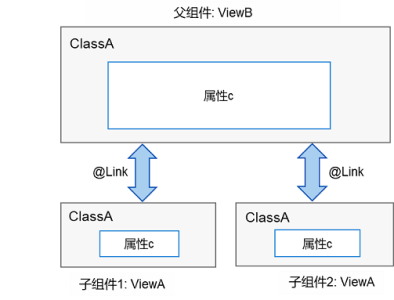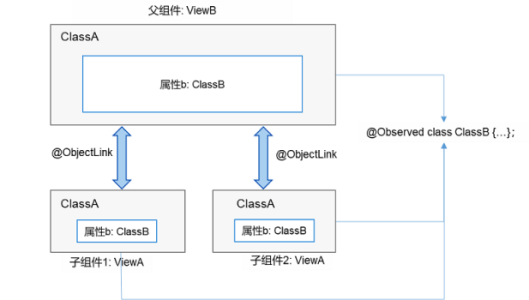

Harmony 鸿蒙页面级变量的状态管理
电子说
描述
页面级变量的状态管理
@State、@Prop、@Link、@Provide、@Consume、@ObjectLink、@Observed和@Watch用于管理页面级变量的状态。
@State
@State装饰的变量是组件内部的状态数据,当这些状态数据被修改时,将会调用所在组件的build方法进行UI刷新。
@State状态数据具有以下特征:
- 支持多种类型数据:支持class、number、boolean、string强类型数据的值类型和引用类型,以及这些强类型构成的数组,即Array、Array、Array、Array。不支持object和any。
- 支持多实例:组件不同实例的内部状态数据独立。
- 内部私有:标记为@State的属性是私有变量,只能在组件内访问。
- 需要本地初始化:必须为所有@State变量分配初始值,变量未初始化可能导致未定义的框架异常行为。
- 创建自定义组件时支持通过状态变量名设置初始值:在创建组件实例时,可以通过变量名显式指定@State状态变量的初始值。
示例:
在下面的示例中:
- 用户定义的组件MyComponent定义了@State状态变量count和title。如果count或title的值发生变化,则执行MyComponent的build方法来重新渲染组件;
- EntryComponent中有多个MyComponent组件实例,第一个MyComponent内部状态的更改不会影响第二个MyComponent;
- 创建MyComponent实例时通过变量名给组件内的变量进行初始化,如:
MyComponent({ title: { value: 'Hello World 2' }, count: 7 })
// xxx.ets
class Model {
value: string
constructor(value: string) {
this.value = value
}
}
@Entry
@Component
struct EntryComponent {
build() {
Column() {
MyComponent({ count: 1, increaseBy: 2 }) // 第1个MyComponent实例
MyComponent({ title: { value: 'Hello World 2' }, count: 7 }) // 第2个MyComponent实例
}
}
}
@Component
struct MyComponent {
@State title: Model = { value: 'Hello World' }
@State count: number = 0
private toggle: string = 'Hello World'
private increaseBy: number = 1
build() {
Column() {
Text(`${this.title.value}`).fontSize(30)
Button('Click to change title')
.margin(20)
.onClick(() = > {
// 修改内部状态变量title
this.title.value = (this.toggle == this.title.value) ? 'Hello World' : 'Hello ArkUI'
})
Button(`Click to increase count=${this.count}`)
.margin(20)
.onClick(() = > {
// 修改内部状态变量count
this.count += this.increaseBy
})
}
}
@Prop
@Prop与@State有相同的语义,但初始化方式不同。@Prop装饰的变量必须使用其父组件提供的@State变量进行初始化,允许组件内部修改@Prop变量,但变量的更改不会通知给父组件,父组件变量的更改会同步到@prop装饰的变量,即@Prop属于单向数据绑定。
@Prop状态数据具有以下特征:
- 支持简单类型:仅支持number、string、boolean等简单数据类型;
- 私有:仅支持组件内访问;
- 支持多个实例:一个组件中可以定义多个标有@Prop的属性;
- 创建自定义组件时将值传递给@Prop变量进行初始化:在创建组件的新实例时,必须初始化所有@Prop变量,不支持在组件内部进行初始化。
说明:
@Prop修饰的变量不能在组件内部进行初始化。
示例:
在下面的示例中,当按“+1”或“-1”按钮时,父组件状态发生变化,重新执行build方法,此时将创建一个新的CountDownComponent组件实例。父组件的countDownStartValue状态变量被用于初始化子组件的@Prop变量,当按下子组件的“count - costOfOneAttempt”按钮时,其@Prop变量count将被更改,CountDownComponent重新渲染,但是count值的更改不会影响父组件的countDownStartValue值。
// xxx.ets
@Entry
@Component
struct ParentComponent {
@State countDownStartValue: number = 10 // 初始化countDownStartValue
build() {
Column() {
Text(`Grant ${this.countDownStartValue} nuggets to play.`).fontSize(18)
Button('+1 - Nuggets in New Game')
.margin(15)
.onClick(() = > {
this.countDownStartValue += 1
})
Button('-1 - Nuggets in New Game')
.margin(15)
.onClick(() = > {
this.countDownStartValue -= 1
})
// 创建子组件时,必须在构造函数参数中提供其@Prop变量count的初始值,同时初始化常规变量costOfOneAttempt(非Prop变量)
CountDownComponent({ count: this.countDownStartValue, costOfOneAttempt: 2 })
}
}
}
@Component
struct CountDownComponent {
@Prop count: number
private costOfOneAttempt: number
build() {
Column() {
if (this.count > 0) {
Text(`You have ${this.count} Nuggets left`).fontSize(18)
} else {
Text('Game over!').fontSize(18)
}
Button('count - costOfOneAttempt')
.margin(15)
.onClick(() = > {
this.count -= this.costOfOneAttempt
})
}
}
}
@Link
@Link装饰的变量可以和父组件的@State变量建立双向数据绑定:
- 支持多种类型:@Link支持的数据类型与@State相同,即class、number、string、boolean或这些类型的数组;
- 私有:仅支持组件内访问;
- 单个数据源:父组件中用于初始化子组件@Link变量的必须是父组件定义的状态变量;
- 双向通信:子组件对@Link变量的更改将同步修改父组件中的@State变量;
- 创建自定义组件时需要将变量的引用传递给@Link变量,在创建组件的新实例时,必须使用命名参数初始化所有@Link变量。@Link变量可以使用@State变量或@Link变量的引用进行初始化,@State变量可以通过'$'操作符创建引用。
说明:
@Link修饰的变量不能在组件内部进行初始化。
简单类型示例:
@Link语义是从''操作符引出,即isPlaying是this.isPlaying内部状态的双向数据绑定。当单击子组件PlayButton中的按钮时,@Link变量更改,PlayButton与父组件中的Text和Button将同时进行刷新,同样地,当点击父组件中的Button修改this.isPlaying时,子组件PlayButton与父组件中的Text和Button也将同时刷新。
// xxx.ets
@Entry
@Component
struct Player {
@State isPlaying: boolean = false
build() {
Column() {
PlayButton({ buttonPlaying: $isPlaying })
Text(`Player is ${this.isPlaying ? '' : 'not'} playing`).fontSize(18)
Button('Parent:' + this.isPlaying)
.margin(15)
.onClick(() = > {
this.isPlaying = !this.isPlaying
})
}
}
}
@Component
struct PlayButton {
@Link buttonPlaying: boolean
build() {
Column() {
Button(this.buttonPlaying ? 'pause' : 'play')
.margin(20)
.onClick(() = > {
this.buttonPlaying = !this.buttonPlaying
})
}
}
}
复杂类型示例:
// xxx.ets
@Entry
@Component
struct Parent {
@State arr: number[] = [1, 2, 3]
build() {
Column() {
Child({ items: $arr })
Button('Parent Button: splice')
.margin(10)
.onClick(() = > {
this.arr.splice(0, 1, 60)
})
ForEach(this.arr, item = > {
Text(item.toString()).fontSize(18).margin(10)
}, item = > item.toString())
}
}
}
@Component
struct Child {
@Link items: number[]
build() {
Column() {
Button('Child Button1: push')
.margin(15)
.onClick(() = > {
this.items.push(100)
})
Button('Child Button2: replace whole item')
.margin(15)
.onClick(() = > {
this.items = [100, 200, 300]
})
}
}
}
@Link、@State和@Prop结合使用示例:
下面示例中,ParentView包含ChildA和ChildB两个子组件,ParentView的状态变量counter分别用于初始化ChildA的@Prop变量和ChildB的@Link变量。
- ChildB使用@Link建立双向数据绑定,当ChildB修改counterRef状态变量值时,该更改将同步到ParentView和ChildA共享;
- ChildA使用@Prop建立从ParentView到自身的单向数据绑定,当ChildA修改counterVal状态变量值时,ChildA将重新渲染,但该更改不会传达给ParentView和ChildB。
// xxx.ets
@Entry
@Component
struct ParentView {
@State counter: number = 0
build() {
Column() {
ChildA({ counterVal: this.counter })
ChildB({ counterRef: $counter })
}
}
}
@Component
struct ChildA {
@Prop counterVal: number
build() {
Button(`ChildA: (${this.counterVal}) + 1`)
.margin(15)
.onClick(() = > {
this.counterVal += 1
})
}
}
@Component
struct ChildB {
@Link counterRef: number
build() {
Button(`ChildB: (${this.counterRef}) + 1`)
.margin(15)
.onClick(() = > {
this.counterRef += 1
})
}
}
@Observed和ObjectLink数据管理
当开发者需要在子组件中针对父组件的一个变量(parent_a)设置双向同步时,开发者可以在父组件中使用@State装饰变量(parent_a),并在子组件中使用@Link装饰对应的变量(child_a)。这样不仅可以实现父组件与单个子组件之间的数据同步,也可以实现父组件与多个子组件之间的数据同步。如下图所示,可以看到,父子组件针对ClassA类型的变量设置了双向同步,那么当子组件1中变量对应的属性c的值变化时,会通知父组件同步变化,而当父组件中属性c的值变化时,会通知所有子组件同步变化。
然而,上述例子是针对某个数据对象进行的整体同步,而当开发者只想针对父组件中某个数据对象的部分信息进行同步时,使用@Link就不能满足要求。如果这些部分信息是一个类对象,就可以使用@ObjectLink配合@Observed来实现,如下图所示。

设置要求
@Observed用于类,@ObjectLink用于变量。
@ObjectLink装饰的变量类型必须为类(class type)。
- 类要被@Observed装饰器所装饰。
- 不支持简单类型参数,可以使用@Prop进行单向同步。
@ObjectLink装饰的变量是不可变的。
- 属性的改动是被允许的,当改动发生时,如果同一个对象被多个@ObjectLink变量所引用,那么所有拥有这些变量的自定义组件都会被通知进行重新渲染。
@ObjectLink装饰的变量不可设置默认值。
- 必须让父组件中有一个由@State、@Link、@StorageLink、@Provide或@Consume装饰的变量所参与的TS表达式进行初始化。
@ObjectLink装饰的变量是私有变量,只能在组件内访问。
示例
// xxx.ets
// 父组件ViewB中的类对象ClassA与子组件ViewA保持数据同步时,可以使用@ObjectLink和@Observed,绑定该数据对象的父组件和其他子组件同步更新
var nextID: number = 0
@Observed
class ClassA {
public name: string
public c: number
public id: number
constructor(c: number, name: string = 'OK') {
this.name = name
this.c = c
this.id = nextID++
}
}
@Component
struct ViewA {
label: string = 'ViewA1'
@ObjectLink a: ClassA
build() {
Row() {
Button(`ViewA [${this.label}] this.a.c= ${this.a.c} +1`)
.onClick(() = > {
this.a.c += 1
})
}.margin({ top: 10 })
}
}
@Entry
@Component
struct ViewB {
@State arrA: ClassA[] = [new ClassA(0), new ClassA(0)]
build() {
Column() {
ForEach(this.arrA, (item) = > {
ViewA({ label: `#${item.id}`, a: item })
}, (item) = > item.id.toString())
ViewA({ label: `this.arrA[first]`, a: this.arrA[0] })
ViewA({ label: `this.arrA[last]`, a: this.arrA[this.arrA.length - 1] })
Button(`ViewB: reset array`)
.margin({ top: 10 })
.onClick(() = > {
this.arrA = [new ClassA(0), new ClassA(0)]
})
Button(`ViewB: push`)
.margin({ top: 10 })
.onClick(() = > {
this.arrA.push(new ClassA(0))
})
Button(`ViewB: shift`)
.margin({ top: 10 })
.onClick(() = > {
this.arrA.shift()
})
}.width('100%')
}
}
@Provide和@Consume
@Provide作为数据的提供方,可以更新其子孙节点的数据,并触发页面渲染。@Consume在感知到@Provide数据的更新后,会触发当前自定义组件的重新渲染。
说明:
使用@Provide和@Consume时应避免循环引用导致死循环。
@Provide
| 名称 | 说明 |
|---|---|
| 装饰器参数 | 是一个string类型的常量,用于给装饰的变量起别名。如果规定别名,则提供对应别名的数据更新。如果没有,则使用变量名作为别名。推荐使用@Provide(‘alias’)这种形式。 |
| 同步机制 | @Provide的变量类似@State,可以修改对应变量进行页面重新渲染。也可以修改@Consume装饰的变量,反向修改@State变量。 |
| 初始值 | 必须设置初始值。 |
| 页面重渲染场景 | 基础类型(boolean,string,number)变量的改变;@Observed class类型变量及其属性的修改;添加,删除,更新数组中的元素。 |
@Consume
| 类型 | 说明 |
|---|---|
| 初始值 | 不可设置默认初始值。 |
示例
// xxx.ets
@Entry
@Component
struct CompA {
@Provide("reviewVote") reviewVotes: number = 0;
build() {
Column() {
CompB()
Button(`CompA: ${this.reviewVotes}`)
.margin(10)
.onClick(() = > {
this.reviewVotes += 1;
})
}
}
}
@Component
struct CompB {
build() {
Column() {
CompC()
}
}
}
@Component
struct CompC {
@Consume("reviewVote") reviewVotes: number
build() {
Column() {
Button(`CompC: ${this.reviewVotes}`)
.margin(10)
.onClick(() = > {
this.reviewVotes += 1
})
}.width('100%')
}
}
@Watch
@Watch用于监听状态变量的变化,语法结构为:
@State @Watch("onChanged") count : number = 0
如上所示,给状态变量增加一个@Watch装饰器,通过@Watch注册一个回调方法onChanged, 当状态变量count被改变时, 触发onChanged回调。
装饰器@State、@Prop、@Link、@ObjectLink、@Provide、@Consume、@StorageProp以及@StorageLink所装饰的变量均可以通过@Watch监听其变化。
说明:
深层次数据修改不会触发@Watch回调,例如无法监听数组中对象值的改变。
// xxx.ets
@Entry
@Component
struct CompA {
@State @Watch('onBasketUpdated') shopBasket: Array< number > = [7, 12, 47, 3]
@State totalPurchase: number = 0
@State addPurchase: number = 0
aboutToAppear() {
this.updateTotal()
}
updateTotal(): void {
let sum = 0;
this.shopBasket.forEach((i) = > {
sum += i
})
// 计算新的购物篮总价值,如果超过100,则适用折扣
this.totalPurchase = (sum < 100) ? sum : 0.9 * sum
return this.totalPurchase
}
// shopBasket更改时触发该方法
onBasketUpdated(propName: string): void {
this.updateTotal()
}
build() {
Column() {
Button('add to basket ' + this.addPurchase)
.margin(15)
.onClick(() = > {
this.addPurchase = Math.round(100 * Math.random())
this.shopBasket.push(this.addPurchase)
})
Text(`${this.totalPurchase}`)
.fontSize(30)
}
}
}
审核编辑 黄宇
-
HarmonyOS实践之应用状态变量共享2023-12-27 0
-
Harmony 鸿蒙页面级变量的状态管理2024-01-24 0
-
Harmony如何管理网页2019-07-30 0
-
跟阿斌一起学鸿蒙(4). 分布式Hello Harmony的N种写法2020-12-07 0
-
如何设置鸿蒙harmony控件的高度是屏幕的一半?2022-03-23 0
-
OpenHarmony应用ArkUI 状态管理开发范例2023-09-01 0
-
OpenHarmony页面级UI状态存储:LocalStorage2023-10-17 0
-
鸿蒙 OS 应用开发初体验2023-11-02 0
-
状态变量滤波器,状态变量滤波器原理是什么?2010-03-24 6279
-
OpenHarmony页面级变量的状态管理2022-12-07 2092
-
鸿蒙开发教程-管理组件状态2024-01-22 773
-
Harmony 鸿蒙应用级变量的状态管理2024-01-24 156
-
鸿蒙OS开发实例:【应用状态变量共享】2024-04-03 682
全部0条评论

快来发表一下你的评论吧 !

